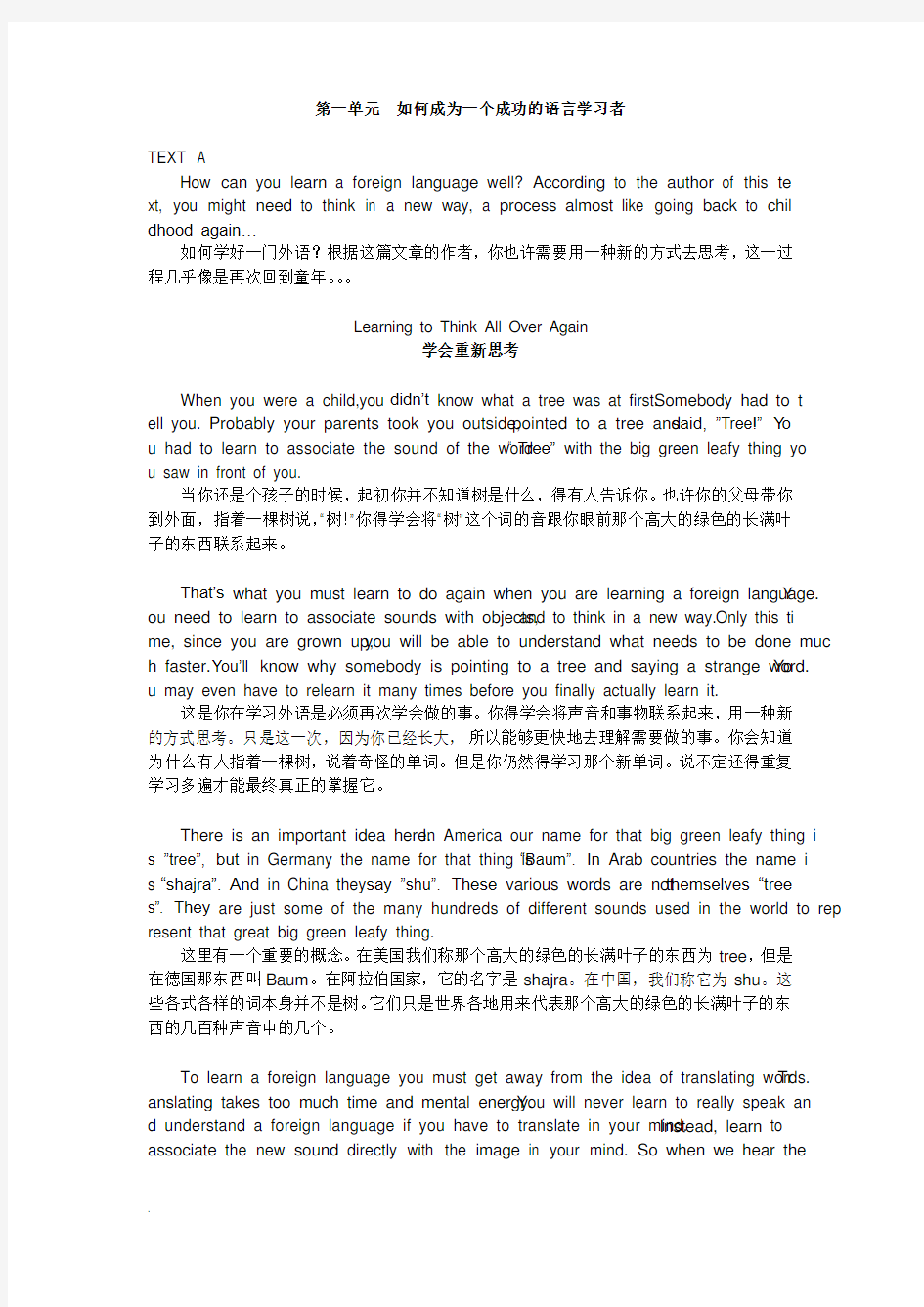
大学英语精读预备级课文翻译(详细)
- 格式:doc
- 大小:70.00 KB
- 文档页数:14


第一单元如何成为一个成功的语言学习者
TEXT A
How can you learn a foreign language well? According to the author of this te xt, you might need to think in a new way, a process almost like going back to chil dhood again…
如何学好一门外语?根据这篇文章的作者,你也许需要用一种新的方式去思考,这一过程几乎像是再次回到童年。。。
Learning to Think All Over Again
学会重新思考
When you were a child, you didn’t know what a tree was at first. Somebody had to t ell you. Probably your parents took you outside, pointed to a tree and said, ”Tree!” Yo u had to learn to associate the sound of the word “Tree” with the big green leafy thing yo u saw in front of you.
当你还是个孩子的时候,起初你并不知道树是什么,得有人告诉你。也许你的父母带你到外面,指着一棵树说,“树!”你得学会将“树”这个词的音跟你眼前那个高大的绿色的长满叶子的东西联系起来。
That’s what you must learn to do again when you are learning a foreign language. Y ou need to learn to associate sounds with objects, and to think in a new way. Only this ti me, since you are grown up, you will be able to understand what needs to be done muc h faster. You’ll know why somebody is pointing to a tree and saying a strange word. Yo u may even have to relearn it many times before you finally actually learn it.
这是你在学习外语是必须再次学会做的事。你得学会将声音和事物联系起来,用一种新的方式思考。只是这一次,因为你已经长大,所以能够更快地去理解需要做的事。你会知道为什么有人指着一棵树,说着奇怪的单词。但是你仍然得学习那个新单词。说不定还得重复学习多遍才能最终真正的掌握它。
There is an important idea here. In America our name for that big green leafy thing i s ”tree”, but in Germany the name for that thing is “Baum”. In Arab countries the name i s “shajra”. And in China they say ”shu”. These various words are not themselves “tree s”. They are just some of the many hundreds of different sounds used in the world to rep resent that great big green leafy thing.
这里有一个重要的概念。在美国我们称那个高大的绿色的长满叶子的东西为tree,但是在德国那东西叫Baum。在阿拉伯国家,它的名字是shajra。在中国,我们称它为shu。这些各式各样的词本身并不是树。它们只是世界各地用来代表那个高大的绿色的长满叶子的东西的几百种声音中的几个。
To learn a foreign language you must get away from the idea of translating words. Tr anslating takes too much time and mental energy. You will never learn to really speak an d understand a foreign language if you have to translate in your mind. Instead, learn to associate the new sound directly with the image in your mind. So when we hear the
sound ”Baum” or ”shajra” or ”shu”, we don’t want to think, ”Hmmmm. Baum means t ree, which means that great big green leafy thing.”
要学习外语,你必须摆脱逐词翻译的想法。翻译会消耗太多的时间和脑力。如果你字字都得翻译,那你永远也学不会真正地说和理解一门外语。相反,你得学会将新的声音和头脑中的形象直接联系起来。这样当我们听见Baum,shajra,或shu等音时,就不会去想“嗯,Baum的意思是树,树指的是哪个高大的绿色的长满叶子的东西。”
Don’t think that the challenge of new thinking will be limited only to the area of new w ords it is going to go much deeper than that. Let’s use an analogy: you can build a hous e using materials of very different sizes and shapes. English uses one set of building blo cks, but other languages will use different-shaped building blocks that take some creativit y to put together at first . Where we use two blocks, they may use three smaller ones—o r maybe one large one.
别以为学习用新的方式思考的挑战仅限于新词:它涵盖的范围要广得多。让我们打一个比方,你能用不同大小和形状的材料造一栋房子。英语使用一套构成要素,但其他语言可能使用不同的构成要素,起初还得用一些创造力才能将它们拼起来。我们使用两个构成要素,而别人也许使用三个较小的——也可能是一个大的。
Here an example of an English sentence: We have to buy a few books before goin
g home. When translating into almost any foreign language, you will not take each Englis
h word and substitute a foreign word for it .You will instead be substituting groups of word s or ideas from one language to the other. How each language will choose to group the i deas depends on the language. In French or Spanish, for example, we have to buy is br oken down into three words: we/have to /buy .In Turkish, however, the Turks are to redu ce all these four words to only one.
以一个英语句子为例:We have to buy a few books before going home.不论将它翻译成哪种外语,你都不会取出每个单词然后逐个地用外语单词去替代。相反你会用成组的词语或者思想从一种语言替代成另外一种语言。至于每种语言如何选择词来表达某个概念,各种语言不尽相同。比如,在法语和西班牙语中,we have to buy被分成三个词:we /ha ve to /buy.而在土耳其语中,土耳其人能将所有这四个词缩减成一个。
So learn to start thinking in terms of bundles of concepts or ideas that will be convert ed to new language and not single words. Try to think in a foreign language. This isn’t al l that hard. You learn to think in the language simply by using the language over and ove r again, asking and answering simple questions until you feel comfortable with the practi ce. Then you add some new words, and a few more new situations, and practice u sing them together with all the words you learned in previous lessons. Bit by bit you buil d up skill.
所以学者开始以成组的词的概念或思想去思考,这些概念或思想能转换成新的语言而非单个词语。尝试用外语去思考。这并不那么难。要学会用哪种语言去思考,你只需一遍又一遍地使用它,问并回答简单的问题,直到你对这一过程感到得心应手为止。然后添加一些新的词汇和几个新的情景,练习用在以前课中学习的所有单词来使用它们。渐渐地,你就会掌握这项技能。